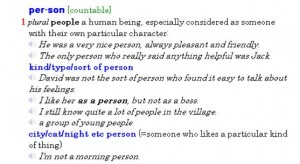You wanted an easy answer, didn’t you! Sorry, I can’t give it to you! You’re learning English!
Let’s say you are learning a new word. A new noun. The reasonable thing to assume that it is a regular noun, and that it is a countable noun and has a plural form. As a rule, the plural form of a noun is constructed by adding an ~s or ~es to the singular form.
In most cases, that would work. But that’s where you may get into Grammar Trouble-ville.
So let’s do some research. Let’s look up a new word in a dictionary.
I looked up the word “man” in my beloved little Webster’s Dictionary that I’ve had since I was a child. It indicated man. n.; pl. MEN . I next turned to my Longman Dictionary of American English that I’ve just taken off of the shelf for this purpose. Right after the main word “man” was a note indicating its part of speech: “n” (for noun) and then “men”. So we’re good in both dictionaries, right from the beginning. We learn the plural form for the noun man is men.
Now I tried this on an online Longman Dictionary of Contemporary English . Go ahead; click on “man 1 noun”.
Right here it says “man plural men“. That’s it! This is a countable noun that has an irregular plural form.
I next tried the common (singular) noun “person“. My little Webster’s Dictionary didn’t say anything about its plural form (“people”). Might this mean that the plural of person is persons? My Longman Dictionary of American English (very helpful for learners of English) had, after all the definitions, at the very end of the entry, a “USAGE” note: “The usual plural of person is people.” You see, there is a plural form of person: persons, but its meaning is not our standard one: We would not say “I saw many persons in the park.” The form persons tends to be legalistic and mathematical.
I tried Longman’s online dictionary: 
This tells us “person [countable]. Now it gives us the first “1” common definition: MALE PERSON [countable}. So now we know we can say “There were many people looking for work.”
Let’s scroll down a little further, to definition #4:

“4 plural persons” And we see this has a different meaning and use, as I wrote above, a more formal use.
So let’s practice and look up the word “woman“: We find woman n women. That tells us the singular is woman, the word is a noun, and the plural is women.
As a rule, the plural form of a noun is constructed by adding an ~s or ~es to the singular form.
How about working this backwards !
Let’s look up “women“. In a hard copy dictionary, we see nothing there! Dictionaries will not list the plural form of a word in its listings. So if this occurs to you, then you will have to figure out what its singular form is. Either put on your thinking cap, or consult a grammar book.
Or look online: and there it is!
Now suppose you look up the word “change” – referring to the coins such as quarters, dimes, nickles and pennies. The next question here is – how do you even know IF a word has a plural form? We have many words in English that do not have a plural form! Nouns such as these are referred to in a number of ways: non-count nouns, non-countable nouns, uncountable nouns. Whatever you call then, you will need to know if the noun even has a plural form.

